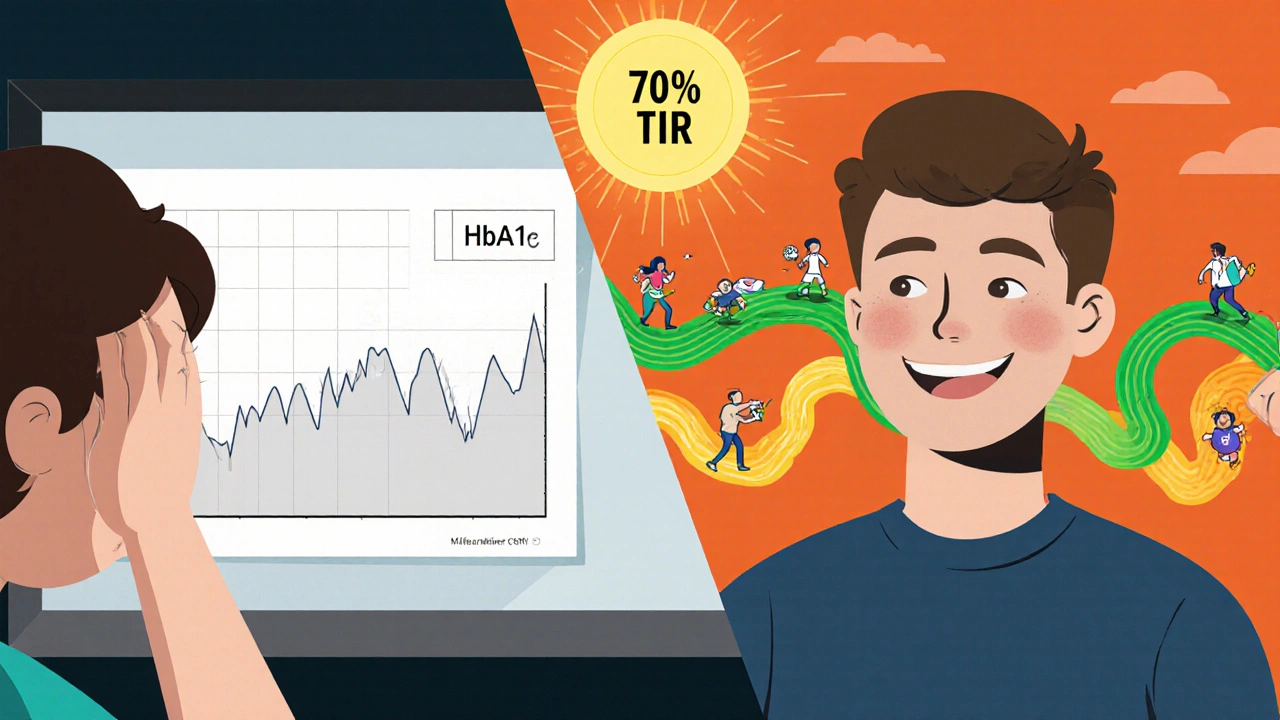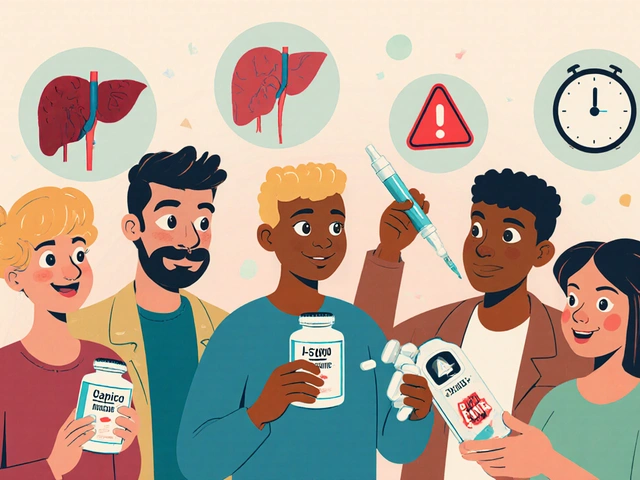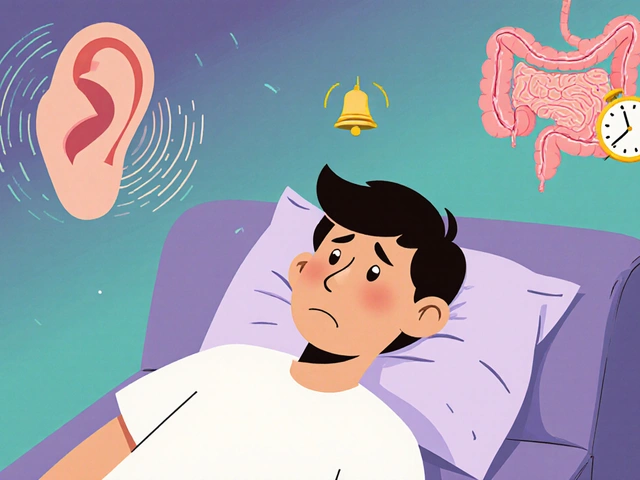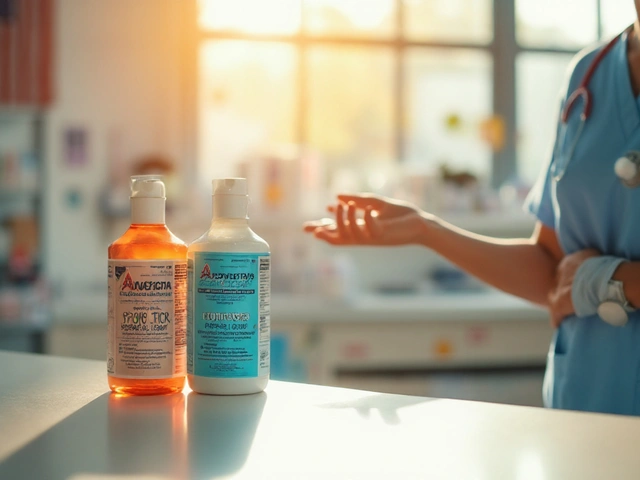For people living with diabetes, managing blood sugar isn’t just about hitting a single number once every three months. It’s about staying steady-day after day, meal after meal, hour after hour. That’s where time in range comes in. Unlike HbA1c, which gives you a three-month average, time in range (TIR) shows you exactly how much of your day your glucose levels are staying safely between 70 and 180 mg/dL. And for the first time, this metric isn’t just for people on insulin. The 2025 American Diabetes Association (ADA) Standards of Care now recommend continuous glucose monitoring (CGM) for nearly all adults with type 2 diabetes who are taking glucose-lowering medications. This isn’t a minor update. It’s a shift in how we think about control.
What Exactly Is Time in Range?
Time in range isn’t a guess. It’s a precise number calculated from thousands of glucose readings taken every 5 minutes by a CGM device. If your sensor records your blood sugar between 70 and 180 mg/dL for 17 out of 24 hours, your TIR is 70%. That’s the target most clinicians recommend for adults with type 1 or type 2 diabetes. The goal? Spend at least 70% of your day in that sweet spot.
But TIR doesn’t just tell you if you’re in range. It shows you when you’re out of it. Time Below Range (TBR) flags low glucose events-those scary drops under 70 mg/dL. Time Above Range (TAR) catches the spikes after meals or during stress. Together, these numbers paint a full picture. Two people could have the same HbA1c of 7.0%, but one might be spending 80% of their day in range with only 1% below, while the other swings wildly between highs and lows, hitting 50% in range and 10% below. Their HbA1c looks the same. Their risk? Not even close.
Why TIR Beats HbA1c Alone
HbA1c is like reading the summary of a book. You know the ending, but you miss all the twists. TIR is reading the whole story. You see the late-night lows, the post-lunch spikes, the sugar crash after a walk. These patterns matter because they’re linked to real outcomes: hypoglycemia can lead to falls or car accidents. Chronic highs increase your risk of nerve damage, kidney disease, and vision loss.
Research shows that every 10% increase in TIR is linked to a 15-20% reduction in the risk of diabetic retinopathy progression. That’s not theoretical. It’s from large studies tracking people over years. And here’s the kicker: you don’t need perfect numbers to see results. Moving from 50% to 60% TIR-just 2.5 extra hours a day-can reduce hypoglycemia episodes by nearly half. That’s life-changing for someone who’s terrified of lows.
And unlike HbA1c, which only updates every few months, TIR gives feedback in real time. You can see how that extra slice of pizza affected your numbers by 10 p.m. You can adjust your evening insulin dose before bed, not after the damage is done.
How CGM Makes TIR Possible
CGM devices-like Dexcom G7, Abbott FreeStyle Libre, or Medtronic Guardian-are small sensors worn on the arm or belly. They measure glucose in the fluid under your skin, sending updates to your phone or watch every 5 minutes. Over 14 days, that’s over 4,000 data points. That’s not just data. It’s a map of your body’s response to food, sleep, stress, and activity.
These devices don’t need fingerstick calibration anymore. Most are factory-calibrated and last up to 14 days. You don’t have to prick your finger unless you’re feeling symptoms and the reading doesn’t match how you feel. The data syncs automatically. Apps show you trends, not just numbers. You can see if your glucose rises every time you eat rice, or drops after evening walks. That’s personal insight you can’t get from a lab test.

Who Should Be Using TIR?
For years, CGM was mostly for people on insulin. Now, the ADA says: if you’re taking metformin, GLP-1 agonists, SGLT2 inhibitors, or even sulfonylureas, you should consider CGM. Why? Because even non-insulin users get dangerous highs and lows. A 2023 study found that 38% of adults with type 2 diabetes on oral meds had at least one hypoglycemic episode in a month-many didn’t even know it.
Older adults, people with kidney disease, or those with a history of severe lows benefit the most. TIR helps prevent dangerous drops that could lead to hospitalization. Even people with prediabetes or gestational diabetes are starting to use CGM to understand how their body responds to food before full-blown diabetes develops.
And it’s not just for adults. Teens with type 1 diabetes using CGM report feeling more in control, less anxious, and more confident at school and sports. Parents report fewer nighttime checks because the alarm tells them when glucose is dropping.
Getting Started with TIR
Here’s how to begin:
- Ask your doctor about CGM eligibility. With the 2025 ADA guidelines, coverage is expanding. Medicare now covers CGM for type 2 diabetes patients on multiple daily injections or insulin pumps.
- Choose a device. Dexcom and Libre are the most common. Libre doesn’t require a transmitter and reads with a phone scan-easier for some. Dexcom gives real-time alerts.
- Wear it for at least 14 days. Don’t skip days. You need 70% active wear time for the data to be reliable.
- Review your report with your diabetes educator. Look for patterns: Are you high after breakfast? Low after gym? That’s where you make changes.
- Adjust one thing at a time. Maybe it’s eating protein before carbs, or moving your evening walk to after dinner. Small tweaks add up.
Most people need 1-2 visits to learn how to read their reports. Don’t try to fix everything at once. Focus on reducing Time Below Range first. Safety comes before perfection.

Real-Life Impact: Stories from the Field
One man in Birmingham, 62, with type 2 diabetes, was told his HbA1c was 7.2%-"good enough." But his CGM showed he was in range only 45% of the time. He was dropping below 60 mg/dL three times a week, often at night. He didn’t feel symptoms. He thought he was fine. After adjusting his bedtime snack and shifting his metformin dose, his TIR jumped to 75% in 6 weeks. His lows disappeared. He stopped waking up exhausted.
A woman in her 40s noticed her glucose spiked after eating "healthy" oatmeal. Her CGM showed a 220 mg/dL peak. She switched to steel-cut oats with chia seeds and protein. Her post-meal spikes vanished. She didn’t change her calories. She changed her timing and combo. That’s the power of TIR.
Challenges and What to Watch For
CGM isn’t perfect. Sensors can fall off. You might get false alarms. Some people feel overwhelmed by the data. That’s normal. Start simple. Focus on just TIR and TBR for the first month. Don’t obsess over every spike.
Cost is still a barrier. In the UK, NHS access is limited. Private CGM can cost £50-£100 per sensor. But prices are dropping. Abbott’s Libre Sense glucose biosensor is now available over-the-counter in some pharmacies. Insurance coverage is improving-especially since the 2025 ADA guidelines.
And while TIR is powerful, it’s not a replacement for HbA1c. Use both. TIR shows you daily control. HbA1c confirms long-term trends. Together, they’re the best team you’ve got.
The Future of TIR
Next up? "Time in tight range"-keeping glucose between 70 and 140 mg/dL. That’s the range most people without diabetes stay in. Early studies suggest it may further reduce complications. AI tools are being built to predict spikes before they happen, suggesting insulin doses or meal swaps automatically.
By 2030, the global CGM market is expected to hit $18.6 billion. That means more innovation, lower prices, and better access. What’s clear: TIR is no longer a luxury. It’s becoming the new standard of care.
If you’re managing diabetes, your goal shouldn’t be just a "good" HbA1c. It should be spending most of your day feeling stable, confident, and free from the fear of highs and lows. That’s what time in range gives you. Not a number. A life.
What is a good Time in Range percentage for diabetes?
For most adults with type 1 or type 2 diabetes, a good Time in Range is at least 70% of the day-about 17 hours-within the target range of 70-180 mg/dL. This aligns with the American Diabetes Association’s 2025 guidelines and corresponds to an HbA1c of around 7%. Some people aim for higher, like 75-80%, especially if they’re using insulin or have a history of complications. Always discuss your personal target with your healthcare team.
How does CGM differ from traditional fingerstick testing?
Fingerstick tests give you a single snapshot of your blood sugar at one moment. CGM tracks glucose continuously-every 5 minutes-for days. That means you see trends, not just numbers. You can spot a rising glucose before it spikes, or a dropping trend before you feel dizzy. CGM also alerts you to lows, even while you’re asleep. It reduces guesswork and gives you real-time feedback to adjust food, activity, or medication.
Can I use CGM if I don’t take insulin?
Yes. The 2025 ADA Standards of Care now recommend CGM for adults with type 2 diabetes who are taking any glucose-lowering medication-even metformin or GLP-1 drugs like Ozempic. Many people on oral meds still experience dangerous highs and lows they don’t feel. CGM helps them understand how food, stress, or sleep affects their glucose, leading to better decisions without needing insulin.
How often should I replace my CGM sensor?
Most CGM sensors last 10 to 14 days, depending on the brand. Dexcom G7 and Abbott Libre 3 are approved for 14 days of continuous wear. Some older models may need replacement every 7-10 days. Always follow the manufacturer’s instructions. Don’t extend wear beyond the recommended time-it can affect accuracy and increase skin irritation risk. Replace it promptly when the device alerts you or when adhesive starts lifting.
Is Time in Range covered by insurance?
Coverage is improving. In the U.S., Medicare now covers CGM for type 2 diabetes patients on insulin or multiple daily injections. Many private insurers follow ADA guidelines and cover CGM for non-insulin users too. In the UK, NHS access is limited but expanding. Private options are available through pharmacies or online retailers. Always check with your provider and ask for a prescription-this often improves approval chances.
What’s the difference between TIR, TBR, and TAR?
TIR (Time in Range) is the percentage of time your glucose is between 70-180 mg/dL. TBR (Time Below Range) is time spent under 70 mg/dL-this is hypoglycemia. TAR (Time Above Range) is time over 180 mg/dL-hyperglycemia. A good balance is at least 70% TIR, less than 4% TBR, and less than 25% TAR. These numbers are shown on your CGM app and help you see where to focus your efforts.
Can TIR help prevent diabetes complications?
Yes. Research shows that higher TIR is linked to lower risks of diabetic eye disease, kidney damage, and nerve problems. Every 10% increase in TIR reduces retinopathy progression by 15-20%. While long-term studies are still ongoing, the evidence is strong enough that the ADA now considers TIR a key metric for preventing complications-not just managing daily highs and lows.







Matthew Mahar
November 22, 2025 AT 22:28Okay but like… I just got my Libre 3 last week and I’m already obsessed. I had no idea my glucose spiked to 210 after eating that "healthy" avocado toast. Like, WHAT. Now I know to add peanut butter. Life changed. I used to think I was doing fine because my A1c was 6.9. Turns out I was just surviving on adrenaline and luck.
Also, the alerts at 3 a.m. saved me from a seizure. No cap. If you’re on meds and not using CGM, you’re basically flying blind. Just saying.
Brandy Walley
November 24, 2025 AT 04:41Stop selling this like it’s the second coming. I’ve had diabetes for 20 years and I’ve seen every shiny new gadget come and go. CGM is expensive, annoying, and most people don’t even know how to read the damn graphs. You think telling me I was in range 70% of the time is gonna make me feel better when I’m still terrified of lows?
Also why is everyone suddenly a diabetes expert on Reddit? I’ll stick with my fingersticks and my willpower thanks.
shreyas yashas
November 24, 2025 AT 10:41As someone from India where CGM access is still limited and expensive, I want to say this: the real win here isn’t the tech-it’s the shift in mindset. We’ve been trained to just chase HbA1c like it’s a finish line. But TIR? It’s about daily peace. My cousin on metformin had silent lows for years. No symptoms. No idea. Then he got a borrowed CGM for two weeks. Found out he was below 70 for 12% of his day. Changed his dinner timing. Now he’s sleeping through the night.
It’s not about perfection. It’s about awareness. And that’s something anyone can start with-even if it’s just one day a week with a borrowed device.
Ragini Sharma
November 25, 2025 AT 21:44So let me get this straight… we’re now supposed to wear a tiny robot on our arm so we can feel guilty every time we eat rice? Cool. I’ll just keep eating my biryani and blaming my A1c. At least that’s an easy excuse.
Also, why does every article about diabetes now sound like a Dexcom commercial? "Your body’s a puzzle! Your data is a map!" Ugh. I just want to eat my food without a lecture.
Linda Rosie
November 26, 2025 AT 18:17Time in range is a clinically validated metric. The 2025 ADA guidelines reflect robust longitudinal data. Adoption improves outcomes. This is not anecdotal. It is evidence-based practice.
Vivian C Martinez
November 27, 2025 AT 20:13I’ve been helping people with type 2 diabetes for 12 years and this is the biggest game-changer I’ve seen since metformin. One client, 71, was having 3-4 lows a week-no symptoms. She thought she was fine. CGM showed her TBR was 11%. We adjusted her sulfonylurea dose and added a bedtime snack. Now she’s at 78% TIR and hasn’t had a fall in 6 months.
You don’t need to be perfect. Just better than yesterday. One extra hour in range? That’s a win.
Ross Ruprecht
November 28, 2025 AT 09:24Why are we even talking about this? Everyone knows CGM is just a fancy glucose tracker. I’ve had diabetes since I was 10. I know my body. I don’t need an app telling me when I’m about to crash. It’s just more noise. And the cost? Please. I’m on SSD. This isn’t a luxury I can afford.
Bryson Carroll
November 29, 2025 AT 13:3270% TIR? That’s pathetic. People without diabetes stay in 70-140 for 90% of the day. You’re celebrating being barely functional. And the ADA? They’re just pandering to Medtronic and Dexcom’s quarterly earnings. This isn’t medicine-it’s corporate surveillance disguised as care. You’re being monetized, folks. Your glucose data is worth more than your blood.
Also, "time in tight range"? Next they’ll be charging you per minute spent in range. Welcome to diabetes capitalism.
Jennifer Shannon
November 29, 2025 AT 20:53I’ve been thinking a lot about this lately-not just as someone with type 1, but as someone who’s watched my grandmother navigate diabetes in the 80s with no tech at all. She had a glucometer that beeped once a day. She’d test after meals, write it down in a notebook, and cry when the numbers were bad. No patterns. No alerts. Just guilt.
Now we have this-this beautiful, noisy, overwhelming flood of data that tells us not just what happened, but why. And yes, it’s expensive. And yes, it’s a lot. But for the first time, we’re not just surviving the disease-we’re understanding it. That’s not just medical progress. It’s emotional liberation.
I used to feel like my body was a betrayal. Now? I feel like I’m finally learning its language. And that… that changes everything.
Suzan Wanjiru
November 30, 2025 AT 20:14My doctor told me to get a CGM because I’m on Ozempic and my A1c was 7.4. I thought it was overkill. Then I saw my post-dinner spikes hit 230 after eating my "healthy" salad with dried cranberries. Turns out, sugar is sugar. I switched to nuts and berries. TIR went from 55% to 73% in 3 weeks.
Also, the alarm woke me up once when I was crashing at 58. I ate a banana. Didn’t pass out. That’s not magic. That’s science. And it’s free for me through insurance. If you’re eligible, just do it. Don’t overthink it.
Kezia Katherine Lewis
December 1, 2025 AT 18:58It’s important to contextualize TIR within the broader framework of metabolic health optimization. While the 70-180 mg/dL range is clinically endorsed, individualized glycemic targets must be stratified by age, comorbidities, and hypoglycemia awareness status. The utility of CGM-derived metrics is maximized when integrated into a shared decision-making model with certified diabetes care and education specialists.
Additionally, data granularity must be balanced with psychological burden. Over-monitoring can induce diabetes distress-a validated construct in behavioral endocrinology. Therefore, phased implementation, starting with TIR and TBR, is recommended to mitigate information overload.
Henrik Stacke
December 3, 2025 AT 06:06Back in the UK, NHS still makes you jump through hoops to get a CGM-even if you’re on insulin. I had to beg, plead, and send three letters before they gave me a Dexcom. And now? I’m in range 80% of the time. I’ve stopped missing work because I was too dizzy. My wife says I’m a different person.
I know it’s expensive. I know it’s not perfect. But if this tech can turn a life of fear into a life of control… then it’s worth every penny. And if you’re not using it yet? You’re not lazy. You’re just not been given the chance. Let’s fix that.
Manjistha Roy
December 4, 2025 AT 11:35I’m a nurse in Delhi, and I’ve seen too many patients with type 2 diabetes come in with HbA1c of 8.5, and say, "But I don’t feel sick." They don’t know they’re having silent lows or spikes. We borrow CGMs from the hospital and let them wear it for 7 days. The change is immediate. One man stopped eating white rice after seeing his numbers. Another started walking after dinner. No meds changed. Just awareness.
This isn’t about technology. It’s about dignity. To know your body. To not live in fear. To not be told "it’s fine" when it’s not. If you can get access, even for a week-do it. It’s not a luxury. It’s a right.